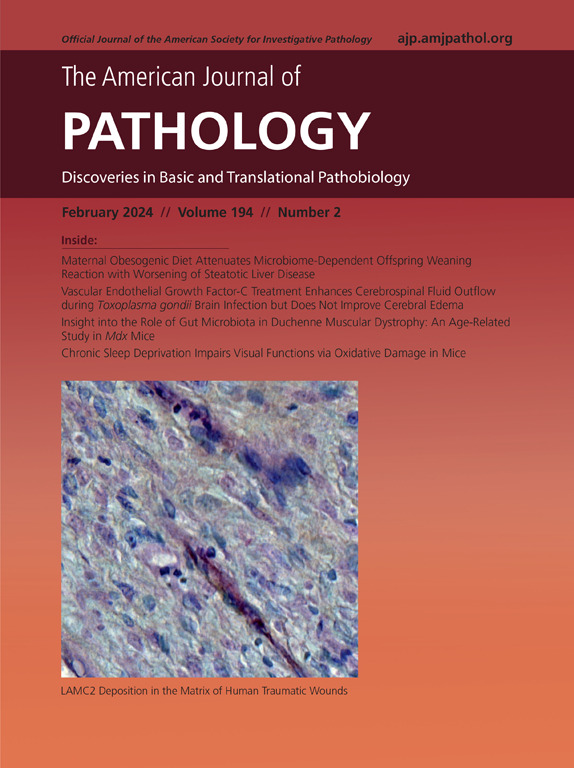Parenchymal and Dyshoric Fibrillar Amyloid Pathology in the rTg-D Rat Model of Cerebral Amyloid Angiopathy Type-2
IF 3.6
2区 医学
Q1 PATHOLOGY
引用次数: 0
Abstract
Cerebral amyloid angiopathy (CAA) is a common age-related disorder, a prominent comorbidity of Alzheimer disease (AD), and causes vascular cognitive impairment and dementia. A previously developed novel transgenic rat model (rTg-D) expresses the human familial CAA Dutch E22Q mutant amyloid β-protein in brain with hemizygous (HEM) animals developing arteriolar CAA type-2 pathology. In this study, homozygous (HOM) rTg-D rats developed more extensive CAA type-2, characterized by abundant fibrillar amyloid accumulation, including parenchymal congophilic plaques and dyshoric vascular amyloid. Similar to the vascular amyloid, fibrillar amyloid plaques in rTg-D HOM rats were predominantly composed of amyloid β40. The rTg-D HOM rats exhibited pronounced astrocytic and microglial responses as well as phosphorylated tau accumulating in surrounding dystrophic neurites and early tangle-like structures. Cerebral proteomic analyses revealed that while rTg-D HEM rats and rTg-D HOM rats shared some common differentially expressed proteins compared with wild-type rats, rTg-D HOM rats exhibited many more elevated proteins. Because the parenchymal fibrillar plaques of rTg-D HOM rats resemble those seen in AD, the cerebral proteomes were compared between rTg-D HOM rats and a transgenic rat model of AD. This analysis showed that they shared many differentially expressed proteins and activated pathways, including activation of transforming growth factor-β1 signaling and swarming of neutrophils. In conclusion, the present findings show that rTg-D HOM rats develop more severe CAA type-2 pathology than rTg-D HEM rats coupled with AD-like pathologic features, making them a valuable model for studying the intersection of vascular amyloidosis and neurodegeneration.
2型脑淀粉样血管病rTg-D大鼠模型的实质和短纤维淀粉样蛋白病理。
脑淀粉样血管病(CAA)是老年人常见疾病,是阿尔茨海默病(AD)的突出合并症,可导致血管性认知障碍和痴呆。此前,一种新的转基因大鼠模型(rTg-D)在大脑中产生人类家族性CAA荷兰E22Q突变体淀粉样β蛋白(a β),半合子(HEM)动物发育小动脉CAA 2型。本研究显示,纯合子rTg-D大鼠发育更广泛的CAA 2型,积累了丰富的纤维状淀粉样蛋白病理,包括实质嗜血性斑块和短促性血管淀粉样蛋白。与血管淀粉样蛋白相似,rTg-D HOM大鼠的纤维状淀粉样斑块主要由Aβ40组成。rTg-D HOM大鼠表现出强烈的星形细胞和小胶质细胞反应,并在周围营养不良的神经突和早期缠结样结构中积累磷酸化tau蛋白。脑蛋白质组学分析显示,与野生型大鼠相比,rTg-D HEM大鼠和rTg-D HOM大鼠具有一些共同的差异表达蛋白(DEPs),尽管rTg-D HOM动物表现出更多的蛋白升高。由于rTg-D HOM大鼠的实质纤维斑块令人联想到AD,我们比较了rTg-D HOM大鼠和转基因大鼠AD模型的大脑蛋白质组学,发现它们共享许多dep和激活途径,包括TGFβ1信号的激活和中性粒细胞的聚集。综上所述,rTg-D HOM大鼠比rTg-D HEM大鼠出现更广泛的CAA 2型,并伴有ad样病理特征。
本文章由计算机程序翻译,如有差异,请以英文原文为准。
求助全文
约1分钟内获得全文
求助全文
来源期刊
CiteScore
11.40
自引率
0.00%
发文量
178
审稿时长
30 days
期刊介绍:
The American Journal of Pathology, official journal of the American Society for Investigative Pathology, published by Elsevier, Inc., seeks high-quality original research reports, reviews, and commentaries related to the molecular and cellular basis of disease. The editors will consider basic, translational, and clinical investigations that directly address mechanisms of pathogenesis or provide a foundation for future mechanistic inquiries. Examples of such foundational investigations include data mining, identification of biomarkers, molecular pathology, and discovery research. Foundational studies that incorporate deep learning and artificial intelligence are also welcome. High priority is given to studies of human disease and relevant experimental models using molecular, cellular, and organismal approaches.

 求助内容:
求助内容: 应助结果提醒方式:
应助结果提醒方式:


